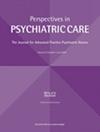在农村精神病门诊中实施视频会诊:可行性研究
IF 1.9
4区 医学
Q2 NURSING
引用次数: 0
摘要
导言。多项疗效研究表明,通过视频会诊(VC)为精神疾病患者提供的治疗效果等同于面对面会诊(IP)。然而,尽管视频会诊大有可为,但尚未在精神科门诊服务中广泛实施。本研究调查了 VC 在临床实践中的可行性,并研究了在精神科门诊服务中实施这种治疗方式的一系列相关因素。研究方法本研究采用务实设计,让 40 名连续转诊的焦虑症、人格障碍或抑郁症患者选择在精神科门诊接受每周八次的 VC 或 IP 治疗。研究收集了通过 VC 进行治疗的需求、接受度、参与度、实施情况和潜在负面影响等方面的信息,以帮助确定可能影响精神科门诊服务中 VC 使用率的因素。结果患者对虚拟视像技术的需求和接受度都很高,44%(n = 15)的患者选择通过虚拟视像技术接受每周八次的治疗,接受度也很高。患者对 VC 模式的参与度很高,只有极少数患者(13%,n = 2)没有完成治疗。患者和个案管理者建立了良好的工作联盟关系,并在整个治疗过程中基本保持了这种关系。与 IP 模式相比,VC 的使用情况有所不同,VC 模式更侧重于支持性咨询,而 IP 模式更侧重于心理治疗。总体而言,通过自愿咨询进行治疗的时间也略短于 IP 咨询。通过视频进行的会诊没有负面影响。结论研究结果表明,在精神科服务中,患者对视频会诊的需求和接受度都很高,参与度和联盟度都很高。与 IP 会诊相比,VC 会诊的重点和持续时间有所不同,这可能反映了临床医生在提供治疗时的不同态度和/或方法,这取决于是 VC 会诊还是 IP 会诊。本文章由计算机程序翻译,如有差异,请以英文原文为准。
Implementing Video Consultations in a Rural Psychiatric Outpatient Clinic: A Feasibility Study
Introduction. Multiple efficacy studies have shown that treatment provided via video consultation (VC) can be equivalent to in-person (IP) consultation for people with psychiatric diagnoses. However, despite the great promise of VC, it has not been widely implemented in psychiatric outpatient services. This study investigated the feasibility aspects of VC in clinical practice and examined a range of factors associated with the implementation of this modality of treatment within psychiatric outpatient services. Methods. This study had a pragmatic design, where 40 consecutive referrals for people with anxiety, personality, or depressive disorders were given the choice to receive eight weekly treatment sessions via VC or IP modality within an outpatient psychiatric setting. Information on demand, acceptance, engagement, implementation, and potential negative effects for treatment conducted via VC were collected to help identify factors that may impact on the uptake of VC within the psychiatric outpatient service. Results. There was a high demand and acceptance for VC, with 44% (n = 15) of the patients choosing to receive eight weekly treatment sessions via VC, and acceptance was rated highly. Engagement with VC modality was good, with only a very small percentage (13%, n = 2) not completing treatment. A good level of working alliance was established and largely maintained throughout treatment for patients and case managers. There were differences in the utilization of VC compared to the IP modality, with the VC modality having a greater focus on supportive counseling and IP modality having a greater focus on psychotherapy. Overall, the duration of treatment conducted via VC was also slightly shorter than that of IP consultations. There were no negative effects registered for consultations via video. Conclusions. Findings suggest a high patient demand and acceptance for VC within psychiatric services, with good levels of engagement and alliance reported. Differences in focus and duration in VC compared to IP may reflect clinicians’ different attitudes and/or approaches to providing treatment, depending on whether it is VC or IP consultations.
求助全文
通过发布文献求助,成功后即可免费获取论文全文。
去求助
来源期刊
CiteScore
5.00
自引率
4.30%
发文量
139
审稿时长
>12 weeks
期刊介绍:
Perspectives in Psychiatric Care (PPC) is recognized and respected as THE journal for advanced practice psychiatric nurses. The journal provides advanced practice nurses with current research, clinical application, and knowledge about psychiatric nursing, prescriptive treatment, and education. It publishes peer-reviewed papers that reflect clinical practice issues, psychobiological information, and integrative perspectives that are evidence-based. Perspectives in Psychiatric Care includes regular columns on the biology of mental illness and pharmacology, the art of prescribing, integrative perspectives, and private practice issues.

 求助内容:
求助内容: 应助结果提醒方式:
应助结果提醒方式:


